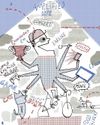The IMD professor describes how the accelerating pace of technological change puts new pressures on established companies.

Whether we praise its genius or dispute its validity, it’s hard to deny the influence of Clayton Christensen’s theory of disruptive in-novation. In explaining the kinds of technological breakthroughs that enable upstarts to challenge industry incumbents, the Harvard Business School professor’s theory changed the way many organizations develop new products and services.
But what happens when the pace of an industry’s change takes off? This is the situation in which many incumbents now find themselves, says Howard Yu, a professor of strategic management and innovation at IMD Switzerland. As he told strategy+business in a recent interview, supply chains are more fluid and business models more agile in the Internet age. And that has implications for both new entrants and established firms. Yu, who earned his DBA (doctor of business administration) degree at Harvard Business School — where he studied under Christensen — believes that disruptive innovation as a theory is as significant today as it was when it was introduced in the mid-1990s. The theory just needs to change with the times.
Yu began his career in the banking industry in his native Hong Kong. His academic research focuses on understanding what drives sustained growth, and what holds some companies back. He investigates innovation in a variety of industries to identify trends, as well as the emerging technologies that enable them. And he advocates for a more open approach to innovation that encourages leaders to see their problems from someone else’s perspective. Yu is also a prolific writer; his columns have appeared in Forbes, Fortune, and the South China Morning Post, among other publications. In 2015, he was selected by Poets & Quants as one of the top 40 b-school professors under 40.
S+B: Why do you believe that the theory of disruptive innovation needs a refresh?
Esta historia es de la edición Fall 2017 de strategy+business.
Comience su prueba gratuita de Magzter GOLD de 7 días para acceder a miles de historias premium seleccionadas y a más de 9,000 revistas y periódicos.
Ya eres suscriptor ? Conectar
Esta historia es de la edición Fall 2017 de strategy+business.
Comience su prueba gratuita de Magzter GOLD de 7 días para acceder a miles de historias premium seleccionadas y a más de 9,000 revistas y periódicos.
Ya eres suscriptor? Conectar

Transforming information into insight
Focus on six organizational elements to build a world-class data and insights capability.

THE URGENT NEED FOR SOPHISTICATED LEADERSHIP
The pandemic has highlighted a series of paradoxes inherent to the work of leaders. What comes next will depend on how well leaders face up to them.

The road to successful change is lined with trade-offs
Rather than trying to convince people your change initiative is the right one, invite them to talk openly about what it might take to implement it: the good, the bad, and the frustrating.

Sustaining productivity virtually
Maintaining productivity levels among remote employees is an enduring challenge. Here are five ways to help businesses and employees thrive while people work at home.

FORWARD TO normal
Entertainment and media companies are building business models that are resilient to the enduring changes in consumer behavior ushered in by COVID-19.

How leaders can promote racial justice in the workplace
Embrace four principles to turn today’s diversity, equity, and inclusion initiatives into sustained progress.

CREATING THE OFFICE OF THE FUTURE
In a remodeled world, it is vital for companies to reinvent ways of working.

Consumer companies must take leaps, not steps
As shoppers show how quickly they can adapt to external shocks, retailers will need to radically reconfigure their business models.

Businesses can fast-track innovation to help during a crisis
“Unrealistic” timelines can actually work. Here’s how.

Agility and experience management work better together
Many companies achieve early wins with separate transformational efforts, then stall. But if combined and enhanced using “return on experience,” or ROX, measures, these two programs can unlock each other’s potential.